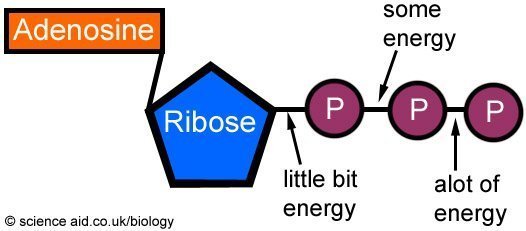Energy and Exercise
Edited by Jamie (ScienceAid Editor), Taylor (ScienceAid Editor), Jen Moreau, R Ellis and 2 others
- 1 ATP and Energy
- 2 Aerobic and Anaerobic
- 3 Muscle Fatigue
-
4 Questions and Answers
- 4.1 I used to enjoy swimming and had a superb feeling after swimming.Nowadays feel tired prematurely and don't enjoy the exercise.I don't know why it is happening?
- 4.2 Physical Symptoms
- 4.3 Hashimoto's performance and psychological symptoms
- 4.4 When is the best time for Hashimoto sufferers to exercise?
- 5 Referencing this Article
- 6 Comments
ATP and Energy
For muscles to contract they need energy. As you probably know, this comes from what we eat: more importantly, it comes from the glucose and triglycerides in the food. But the muscles do not directly get their energy from here. Their immediate source of energy is ATP (Adenosine TriPhosphate) [pronounced - ah-den-o-zyn try-fos-fate] and it has the following structure:
As the diagram shows, there are a string of phosphates coming from the ribose unit which is where ATP gets its energy from. The last bond contains a lot of energy that is released when it's broken down and forms ADP (adenosine DiPhosphate). This is exactly the same as ATP but with one P removed.
To replenish energy reserves, the body uses energy from the respiration to put a P back onto ADP to reform ATP; and thus the molecule is recycled.
Aerobic and Anaerobic
Now that we are looking at this in more detail you must know that there are two types of respiration in humans: aerobic and anaerobic, but rather than being two separate types, they are part of the same pathway.
Anaerobic means without oxygen and the first stage of the reaction does not use any, anaerobic produces ATP. If the reaction continues it will use oxygen to produce even more ATP. However, if there is insufficient oxygen then only anaerobic respiration will take place and lactic (which is acidic) is produced as a by-product. The below table summarizes the two systems.
| Anaerobic | Aerobic | |
|---|---|---|
| Type of Supply | Near maximum for up to 1 minute | Long term exercise but lower intensity |
| ATP produced | 2 per glucose molecule | Up to 36 can be produced per glucose molecule |
| By product | Lactate | Only carbon dioxide |
| Athletic Comparison | 200m to 400m sprints | From 800m to marathons |
Muscle Fatigue
When not enough oxygen is getting to the muscles, the respiration will become more anaerobic. Continuing this will lead to a build up of lactic acid in the muscles. This will cause a pH drop in the blood plasma. This causes muscle fatigue where muscles ache and do not contract correctly because the pH levels interfere with the functioning of the proteins and enzymes. So this is what stops you when you are exercising too much.
All of this built-up of lactic acid does not stay in the blood indefinitely. It is taken to the liver where it is broken down to glycogen via the process of oxidation. This process in the liver however, requires oxygen. So after exercise we breath heavily to get enough oxygen to break down the excess lactate, this is known as an oxygen debt.
Questions and Answers
I used to enjoy swimming and had a superb feeling after swimming.Nowadays feel tired prematurely and don't enjoy the exercise.I don't know why it is happening?
I used to exercise and swimming and used to enjoy a lot. Off late due to hypothyroid. or due to symptoms of Hashimoto's disease, I don't enjoy the same. What is the reason and what should I do?
As Noted by Dr. Kharrazian you must be very careful when working out if you suffer from Hashimoto's.
Physical Symptoms
If you are practicing frequently and you see that you have a debilitated invulnerable framework, lost moxie, loss of menstrual cycle, diminished muscle quality or unexplained increments or reductions in weight then you might be overdoing it.
Hashimoto's performance and psychological symptoms
If you experience serious difficulties from exercises, can't finish your exercises, see your execution is declining or that you have more wounds then you might do excessively. If you are practicing as often as possible and you see lost inspiration and excitement, lost focus or drive, dejection, touchiness or hostility for minor reasons then you may be doing too much.
When is the best time for Hashimoto sufferers to exercise?
The ideal time to get the most advantage is inside 10 minutes after you wake up before you have eaten. This is the ideal time to practice since you can exploit your body's characteristic cortisol surge and practicing before breakfast will likewise help you consume fat all the more productively and help decrease insulin resistance.
An Article in American College of Sports Medicine's Health and Fitness offers a case of an ideal 7-minute exercise that can be utilized as a beginning stage for Hashimoto's patients and can be used to accomplish all the medical advantages without bringing about any of the negative impacts of overtraining.
Referencing this Article
If you need to reference this article in your work, you can copy-paste the following depending on your required format:
APA (American Psychological Association)
Energy and Exercise. (2017). In ScienceAid. Retrieved Apr 23, 2024, from https://scienceaid.net/biology/biochemistry/atp.html
MLA (Modern Language Association) "Energy and Exercise." ScienceAid, scienceaid.net/biology/biochemistry/atp.html Accessed 23 Apr 2024.
Chicago / Turabian ScienceAid.net. "Energy and Exercise." Accessed Apr 23, 2024. https://scienceaid.net/biology/biochemistry/atp.html.
If you have problems with any of the steps in this article, please ask a question for more help, or post in the comments section below.
Comments
Article Info
Categories : Biochemistry
Recent edits by: Sharingknowledge, R Ellis, Jen Moreau




